Ultimate Movie Budget Template for Successful Film Projects
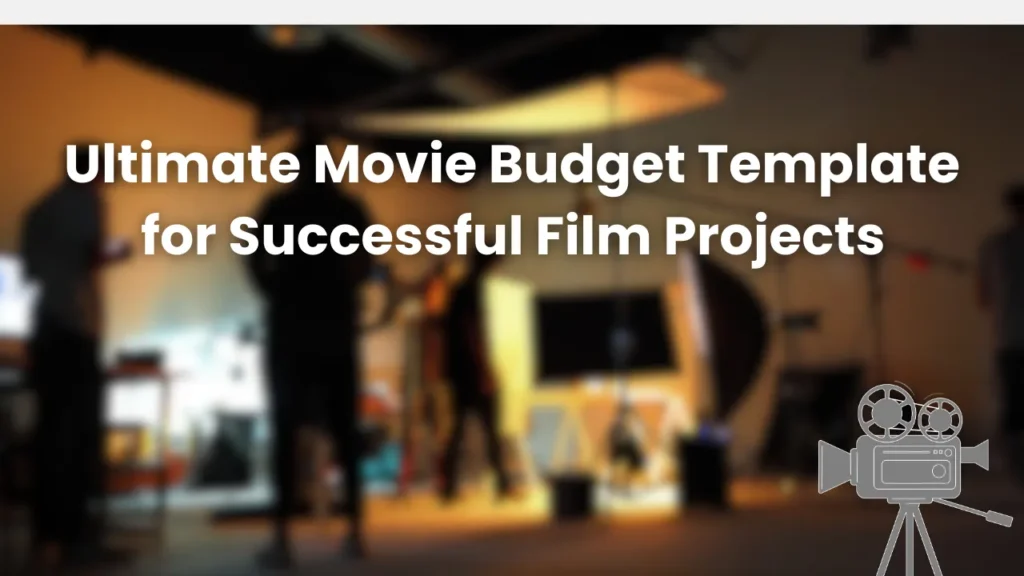
Creating a film is an exciting process, but careful financial planning is essential to avoid unexpected costs and delays. A movie budget template helps filmmakers organize every expense, from pre-production to post-production, ensuring resources are allocated efficiently. Whether you’re working on a short film, an indie project, or a larger production, using a sample film budget template or a structured budget template for film can simplify cost tracking and provide a clear overview of your financial plan. Additionally, leveraging film budgeting software can streamline calculations, making it easier to manage your project and stay on schedule.
Beyond budgeting, integrating storyboarding into your planning can further improve efficiency and reduce unnecessary expenses. Tools like the best storyboard software for filmmakers allow you to visualize scenes before shooting, helping you plan resources more accurately.
What You Should Know Before Creating a Film Budget
Before diving into numbers, it’s important to understand the purpose of a film production budget template. Essentially, it’s a roadmap for your entire project, showing exactly where your money will go, from pre-production to post-production. Proper budgeting helps you avoid overspending, manage unexpected costs, and impress investors with a professional plan.
When creating a budget, accuracy is key. Keep in mind:
- Always include contingency funds of 5–10% for emergencies or last-minute changes.
- Track actual versus estimated costs to keep your project on target.
- Choose the right tools. Film budgeting software like Movie Magic, StudioBinder, and Celtx can automate calculations and make updating budgets much easier. For beginners, a simple Excel or Google Sheet budget template for film can also work.
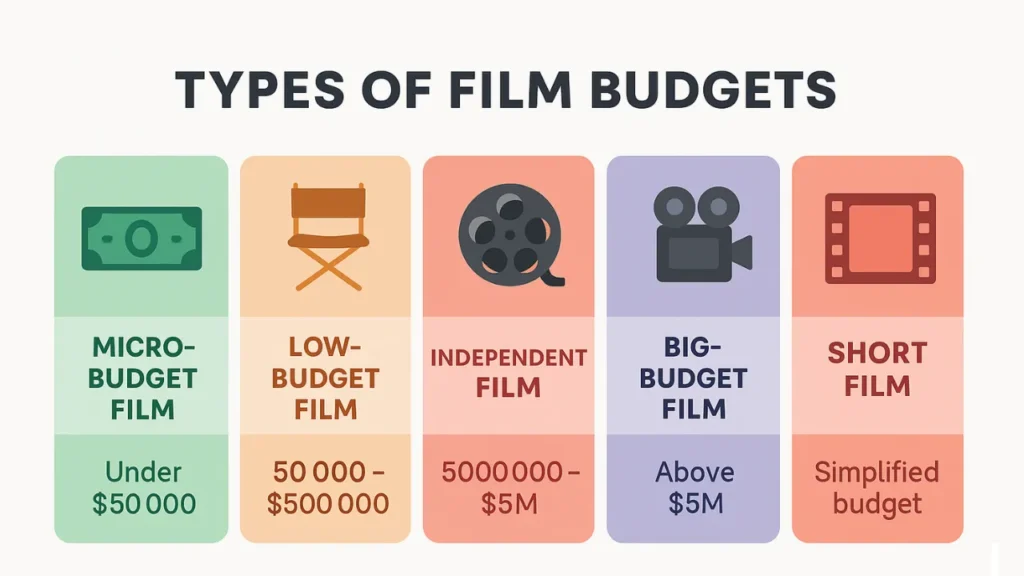
Types of Film Budgets
Not all film budgets are the same. Understanding the type of film you’re producing helps you choose the right template and level of detail.
Micro-Budget Film
These projects usually have a budget under $50,000. They often rely on a small crew, minimal equipment, and limited locations. Many are self-funded or crowdfunded.
Low-Budget Films
Budgets between $50,000 and $500,000 allow for a slightly larger crew and more equipment but still require careful planning.
Independent Films
With budgets ranging from $500,000 to $5 million, indie films can include professional crew, recognizable actors, and higher production value.
Studio or High-Budget Films
Budgets above $5 million involve A-list actors, multiple shooting locations, and extensive visual effects.
Short Films
Usually, low-budget, short films benefit from simplified sample film budget templates, focusing on essential costs.
Animated Films
These require unique budgeting for animation software, voice actors, rendering, and post-production effects.
Key Components of a Film Budget
A thorough film budget breakdown ensures no expense is overlooked. Every budget should include pre-production, production, and post-production costs.

A. Pre-Production Costs
- Script & Story Rights: Purchase rights or pay for original scripts.
- Casting & Auditions: Actor fees, audition space rental, and casting director wages.
- Location Scouting & Permits: Fees for locations and legal permits.
- Film Insurance: Protects against accidents or unexpected events.
- Office/Prep Space Rent: Any space used to organize production work.
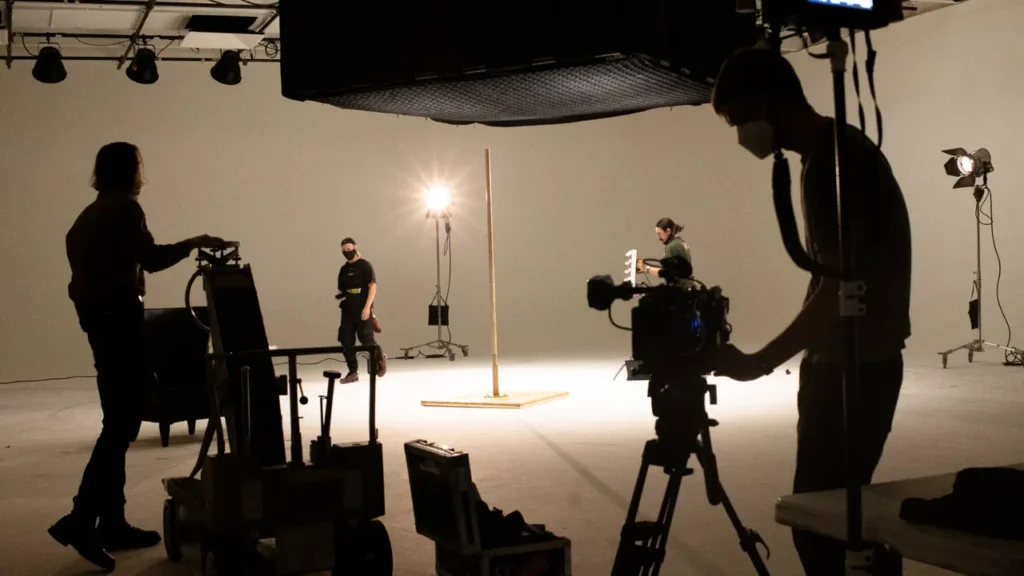
B. Production Costs
- Cast Salaries & daily allowances (per diems): Actor payments and daily allowances.
- Crew Rates: Camera operators, lighting, sound, and production assistants.
- Equipment Rental: Cameras, lighting, and sound equipment.
- Set Design & Props: Construction materials, props, and on-set decor.
- Costumes & Makeup: Wardrobe, makeup artists, and styling.
- Travel & Transportation: Transport for cast, crew, and equipment.
- Catering & Craft Services: Food and refreshments during shooting.
- Contingency Funds: Always include a 5–10% buffer for unexpected costs.
C. Post-Production Costs
- Editing: Video editing software or editor fees.
- Sound Design & Mixing: Audio post-production and soundtracks.
- Visual Effects (VFX): Special effects or CGI work.
- Color Grading: Adjusting colors for professional visual quality.
- Music Licensing or Composition: Original score or licensed tracks.
- Marketing & Distribution: Trailers, posters, festival fees, or promotional campaigns.
Breaking down costs by category not only helps you stay organized but also makes it easier to present your movie budget template to investors or producers.

Types of Film Budget Templates
At Immersfy, we understand that every film production has unique needs, and choosing the right budget template for film is essential for staying organized and on track. Here’s a detailed look at the most common types of movie budget templates:
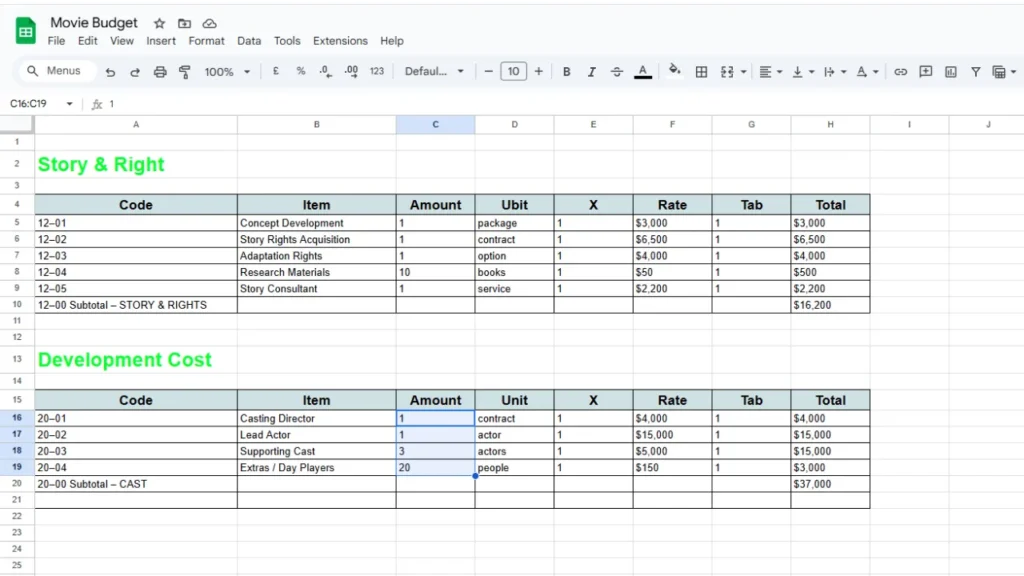
1. Excel / Google Sheet Templates
- These are simple, customizable, and perfect for beginners or small-scale projects.
- You can automatically calculate totals, update costs, and categorize expenses by department.
- Ideal for independent filmmakers who want a hands-on approach to budgeting without investing in expensive software.
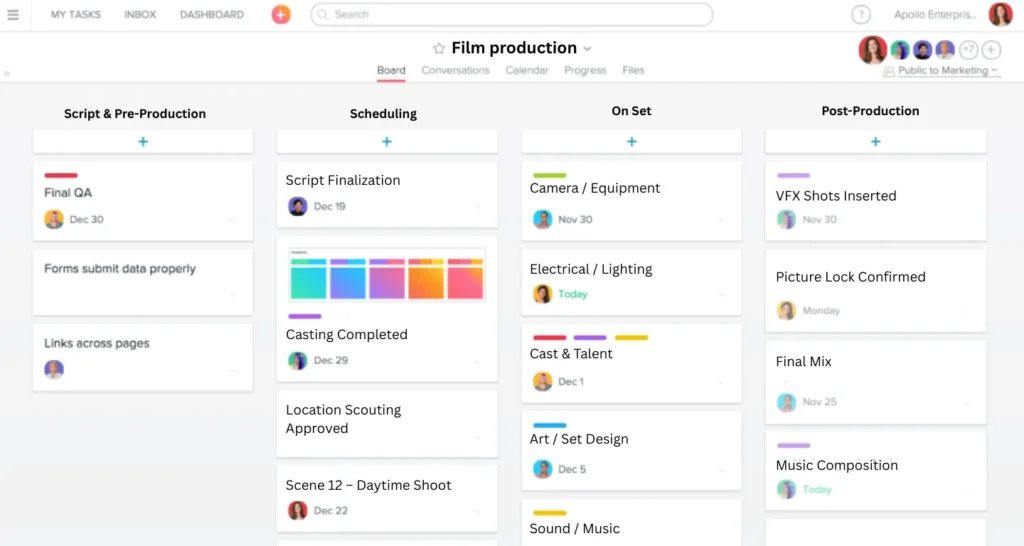
2. Department-Wise Templates
- Breaks down the budget into separate sections such as cast, crew, production, and post-production.
- Helps producers and investors understand exactly where the money is going.
- Useful for medium to large productions where multiple teams are working simultaneously.
3. Day-by-Day Production Budget
- Tracks daily expenses based on the shooting schedule.
- Ensures that every day’s costs, from equipment rental to catering, are accounted for.
- Particularly helpful for productions with tight schedules or multiple locations.
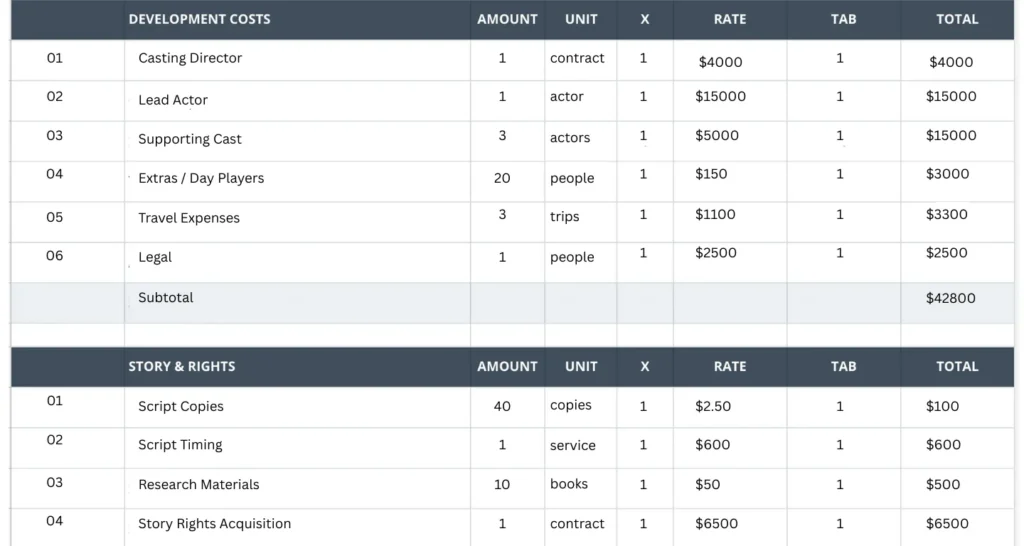
4. Category-Based Budget Templates
- Simplified format ideal for short films, micro-budget films, or student projects.
- Organizes costs by major categories like pre-production, production, and post-production.
- Makes it easy to see the overall picture without being overwhelmed by detailed line items.
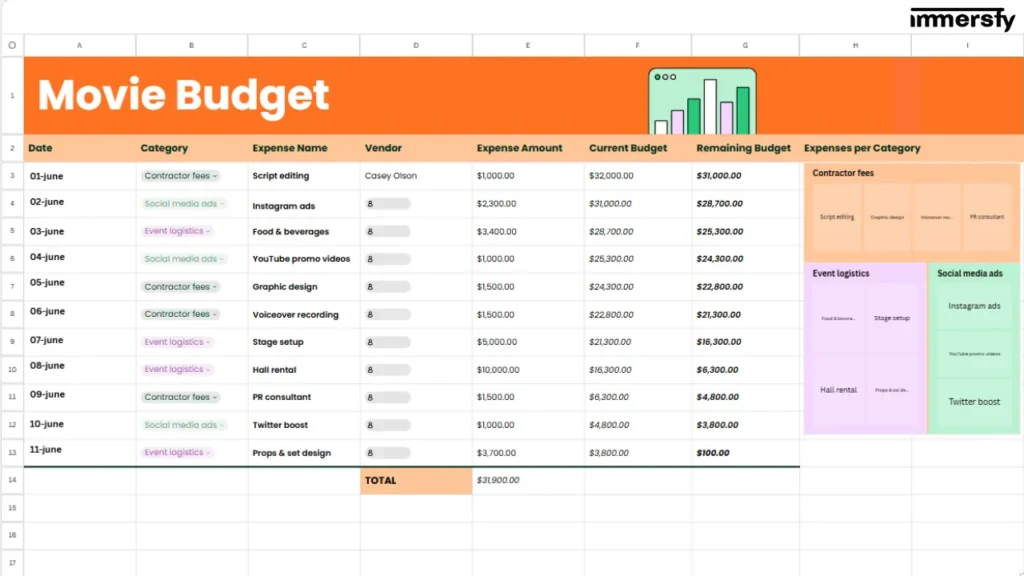
5. Software-Compatible Movie Budget Template
- Designed for use with professional film budgeting software like Movie Magic, StudioBinder, or Celtx.
- Automates calculations and updates, saving time and reducing errors.
- Suitable for large-scale productions or filmmakers looking for a professional-level budgeting solution.
- Ensures a detailed and accurate budget template for film, helping you manage all costs from pre-production to post-production efficiently.
By offering these three templates, Immersfy provides flexible solutions for filmmakers of all levels. Whether you’re creating a micro-budget short film or a large feature, our templates help you plan, track, and control your production expenses with ease.
Tips for Using a Movie Budget Template
To get the most out of your film production budget template, follow these tips:
- Always include contingency funds to handle emergencies.
- Track actual vs estimated costs in real-time.
- Update your budget regularly to reflect changes in production.
- Categorize expenses clearly for clarity with investors or producers.
- Keep both digital and backup copies to prevent data loss.

Common Mistakes in Film Budgeting
Even experienced filmmakers can make mistakes. Avoid these common pitfalls:
- Underestimating post-production costs, especially for editing and VFX.
- Ignoring contingency funds and emergency expenses.
- Forgetting essential costs like insurance or location permits.
- Overlooking travel, catering, and day-to-day on-set expenses.
Bonus Tip: Combine Budgeting with Storyboarding
A powerful way to save time and money during production is to combine budgeting with an AI storyboarding app. A storyboard helps visualize every scene before shooting, reducing unnecessary expenses and reshoots.
If you’re wondering how to create a storyboard for a short film, using the best storyboard software for filmmakers or a digital AI storyboard creator can streamline the process. Not only does this make your production more efficient, but it also complements your film budget template by providing a clear plan for every shot and scene.
At Immersfy, we specialize in creating professional storyboards that integrate seamlessly with your budget planning, helping you save both time and money while improving the overall quality of your film.
FAQs about How to Type a Script
What is a film budget template, and why do I need one?
A Movie budget template is a pre-structured document that lists all the potential expenses in a film project. It saves time, reduces errors, and ensures you don’t miss any hidden costs like insurance, overtime, or marketing. Having a template also helps you present a professional budget to investors and production partners.
How do I break down a film budget?
Film budgets are generally divided into three categories:
- Above-the-Line (ATL): Writers, directors, producers, and main cast.
- Below-the-Line (BTL): Crew salaries, equipment rentals, sets, props, and logistics.
- Post-Production: Editing, sound, color grading, VFX, and final delivery.
This film budget breakdown ensures that every stage of production is accounted for.
When should I start planning my film budget?
Budget planning should start in early pre-production. Begin with a top-level estimate to secure investors or grants. Once funding is confirmed, move to a detailed version using actual vendor quotes and crew rates. The earlier you budget, the fewer surprises you’ll face during production.
What are the essential categories to include in a film budget?
A good budget template for film should cover:
- Script and rights
- Crew and cast payments
- Equipment rentals
- Shooting locations
- Permits and insurance
- Post-production (editing, sound, VFX)
- Marketing and distribution
- Contingency funds (5–10%)
How much should I allocate for contingency and unexpected costs?
Keeping 5–10% of your total budget as a buffer is smart. This covers reshoots, equipment damage, weather delays, or last-minute creative changes. Many successful films credit their contingency planning for staying on schedule.
Should I include prep days, kit fees, and overtime in my budget?
Yes. These small costs quickly add up. Prep days for cast and crew, kit fees for personal gear like cameras or lighting, and overtime pay should always be included to avoid financial surprises.
Where can I find real sample film budget breakdowns?
If you’re just starting, it’s tough to find real-world numbers. That’s why Immersfy offers a free sample film budget template designed to match industry standards. It gives you a realistic structure that you can customize for your project.
Can I budget for a web series or episodic content?
Absolutely. You can create separate budgets per episode or one comprehensive template for the entire season. Immersfy’s template is flexible, making it easy to adapt for web series, commercials, short films, or feature projects.
How do I make my budget appealing to investors?
Investors want clarity and professionalism. Make sure your budget is well-structured, realistic, and transparent. Highlight ROI potential, include contingency funds, and use clear formatting. Templates from Immersfy help present your project in a polished way.
What is the difference between low-budget and high-budget film planning?
Low-budget films prioritize essentials like cast, crew, and locations. Many filmmakers use online AI storyboard maker and indie crew contracts to reduce costs.
High-budget films have room for big stars, special effects, multiple locations, and marketing campaigns.
Both require a detailed budget—just on different scales.
Can storyboarding improve my budgeting process?
Yes. Storyboarding helps identify exact shots, locations, props, and VFX needs, which reduces guesswork in budgeting. If you’re wondering how to create a storyboard for a short film, Immersfy also offers tools and guides that align with budgeting. For more advanced projects, you can even explore the best storyboard software for filmmakers.
How often should I review my film budget?
Ideally, review your budget weekly during pre-production and daily during production. This helps you track actual spending against planned numbers and adjust in real time.
What common mistakes should filmmakers avoid in budgeting?
- Forgetting insurance and permits
- Underestimating post-production costs
- Not including marketing expenses
- Ignoring overtime or reshoot costs
- Overlooking distribution fees
Immersfy’s templates include these categories so you won’t miss them.
Can beginners use a film budget template?
Definitely. Even if you’re new, a sample film budget template makes the process simpler by providing a checklist of all possible expenses. With Immersfy, you can start small and grow as your projects expand.
